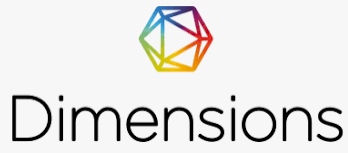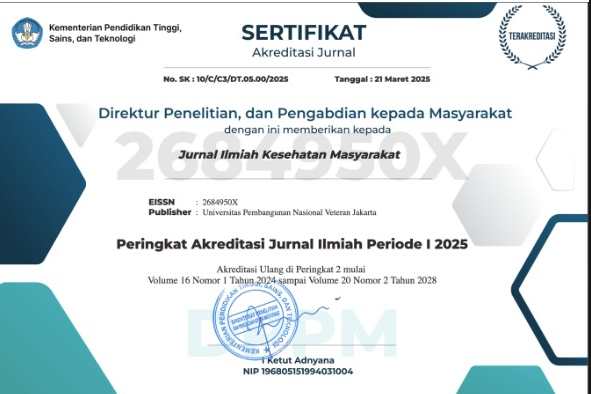Analisis Penyebab Tenaga Kesehatan Terpapar Coronavirus Disease 19 (Covid-19) Di RS X Tahun 2020
Abstract
Abstrak
Latar Belakang: Tenaga kesehatan merupakan setiap orang yang mengabdikan diri dalam bidang kesehatan yang memiliki pengetahuan dan/atau ketrampilan melalui pendidikan di bidang kesehatan. Peran dan kerja nyata tenaga kesehatan dari berbagai jenis profesi sebagai garda terdepan dalam upaya penanganan Coronavirus Disease 2019 (Covid-19) sangat krusial untuk mempercepat penanganan pandemi ini. Memberikan pelayan kepada pasien, terutama kepada pasien Coronavirus Disease 2019 (Covid-19) menyebabkan tenaga kesehatan rentan untuk terpapar Coronavirus Disease 2019 (Covid-19). Penelitian ini bertujuan untuk mendapatkan gambaran penyebab paparan covid-19 pada tenaga kesehatan.
Metode: Penelitian ini bersifat deskriptif dengan pendekatan kualitatif. Informan dalam penelitian ini berjumlah 6 orang dengan rincian 4 orang informan utama, 1 orang informan kunci dan 1 orang informan pendukung. Pengumpulan data dilakukan dengan metode observasi, wawancara dan telaah dokumen.
Hasil: Ketersediaan Alat Pelindung Diri (APD) sesuai dengan peraturan yang berlaku, tetapi ditemukan pengunaan masker N95 dengan sistem UV, tenaga kesehatan bekerja melebihi jam kerjanya dan tidak dapat beristirahat diantara jam kerja dikarenakan penggunaan APD. RS X telah memberikan pendidikan dan pelatihan kepada tenaga kesehatan, tetapi belum menyeluruh dikarenakan jam pelaksanaan dilakukan di jam kerja. Namun, pengawasan penggunaan APD dan pemantauan proaktif deteksi dini di RS X sudah dilakukan sesuai dengan peraturan yang ada.
Kesimpulan: Pada penggunaan masker N95 dengan sistem UV, sebaiknya digunakan dengan maksimal pemakaian 8 jam. Lembar checklist pemenuhan AP Ddiperlukan untuk memantau ketersediaan APD disetiap unit, manajemen rumah sakit dianjurkan dapat mengantur jam kerja dengan menerapkan waktu kerja lebih pendek seperti dengan menerapkan 4 shift kerja setiap harinya.
Kata Kunci: Tenaga kesehatan, Covid-19, Penyebab, APD, Pengawasan
Abstract
Background: Health workers are people who perpetuate themselves in the health sector who have knowledge and/or skills through education in the health sector. The real role and work of health workers from various types of professions as the front line in efforts to deal with Coronavirus Disease 2019 (Covid-19) is very crucial and needed to accelerate the handling of this pandemic. Providing services to patients, especially to patients with Coronavirus Disease 2019 (Covid-19) causes health workers to be vulnerable to being exposed to Coronavirus Disease 2019 (Covid-19).
Methods: This research is descriptive with a qualitative approach. This study's participants comprised six people with details of 4 main informants, one key informant and one supporting informant. Observation, interview and document review methods carried out data collection.
Results: Availability of Personal Protective Equipment (PPE) under applicable regulations, but it was found that using N95 masks with UV systems, health workers worked beyond their working hours and could not rest between working hours due to the use of PPE. Hospital X has provided education and training to health workers, but it needs to be more comprehensive because the hours of implementation are carried out during working hours. However, monitoring the use of PPE and proactive monitoring of early detection at Hospital X have been carried out under existing regulations.
Conclusion: An N95 mask with a UV system should be used for a maximum of 8 hours. The PPE fulfilment checklist sheet is needed to monitor the availability of PPE in each unit; it is recommended that hospital management arrange working hours by implementing shorter working hours, such as four work shifts every day.
Keywords : Health workers, Covid-19, Causes, PPE, Supervision
References
Kementerian Kesehatan Republik Indonesia. Informasi Tentang Virus Corona (COVID-19) - Pemkab Lumajang. Kementerian Kesehatan Republik Indonesia. 2020.
Kemenkes. Situasi Terkini Perkembangan Coronavirus Disease (Covid-19). Kemenkes. 2021;(agustus):1–4.
World Health Organization. Materi Komunikasi Risiko COVID-19 untuk Fasilitas Pelayanan Kesehatan. World Heal Organ. 2020;1–11.
Wang J, Zhou M, Liu F. Reasons for healthcare workers becoming infected with novel coronavirus disease 2019 (COVID-19) in China. J Hosp Infect. 2020;105(1):100–1.
World Health Organization. Health and Care Worker Deaths during COVID-19. World Health Organization. 2021. hal. 19–20.
Direktorat Jenderal Tenaga Kesehatan. Tenaga Kesehatan dan Kasus Positif. 2020. hal. 24–6.
Alajmi J, Jeremijenko AM, Abraham JC, Alishaq M, Concepcion EG, Butt AA, et al. COVID-19 infection among healthcare workers in a national healthcare system: The Qatar experience. Int J Infect Dis. 2020;100:386–9.
PB IDI. Pedoman Standar Perlindungan Dokter di Era Covid-19. 2020 hal. 40.
Kementrian Kesehatan Republik Indonesia. Peraturan Menteri Kesehatan Republik Indonesia Nomor 9 Tahun 2020 Tentang Pedoman Pembatasan Sosial Berskala Besar Dalam Rangka Percepatan Penanganan Corona Virus Disease 2019. Routledge; Agu, 2020.
Ri KK. COVID-19 dalam Angka. 2020.
Keputusan Menteri Kesehatan RI No. 247. Keputusan Menteri Kesehatan No. 247 Tahun 2020 Tentang Pedoman pencegahan dan pengendalian coronavirus disease 2019 (covid-19). 2020;2019:1–127.
Menteri PUPR. Surat Edaran Menteri Ketenagakerjaan Republik Indonesia Nomor M/7/As.02.02/V/2020 Tahun 2020 Tentang Rencana Keberlangsungan Usaha Dalam Menghadapi Pandemi Corona Virus Disease 2019 (Covid-19) Dan Protokol Pencegahan Penularan Covid-19 Di Perusahaan. Media Inf dan Komun Direktorat Jenderal Bina Konstr Kementeri PUPR. 2020;4(Covid-19):2–5.









.jpg)








